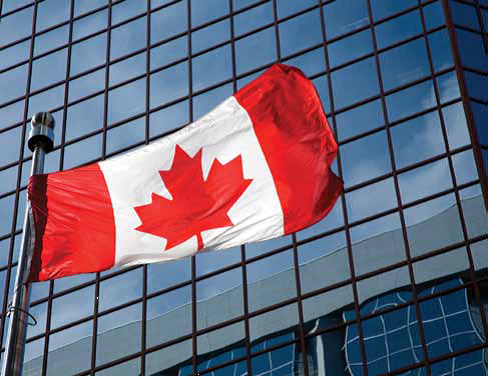By Linda Richardson
Our largest trade partner is right
across the border!
What makes it a great next step in your international sales
effort? They speak English, they have the same international dialing code +1,
and some Americans can see Canada outside their kitchen window, really!
Seriously though, Canadians buy
over $290 Billion in goods from U.S. companies which amounts to 19% of overall US exports There is little language barrier,
English and French are official languages in Canada. 58.4% of Canadians are native English speakers,
22% are native French speakers, mostly in Quebec, which has a large dominant
French speaking population. To enter this market product sold into Canada from
the U.S. must have a bi-lingual label (English and French). Translating your labels
and website will ensure successful entry into this and other markets.
There is a robust ecommerce market in Canada. Canadians
are online savvy and the weather is COLD a good part of the year! This makes online shopping probable enabling
consumers to stay indoors and still find the latest and greatest U.S made
products. As you probably already have an online presence you can enhance that
by adding French to your website, getting listed on ecommerce sites in Canada
and participating in Trade Shows in Canada. The State of PA and the US
Commercial Service is already there and promoting U.S. companies and products.
Call your local office to discuss this affordable door opener as a part of the PA
and U.S. exhibit!
Not ready to cross
the border? Consider selling your products in border U.S. towns and retail outlets.
Many Canadians cross the border taking advantage of the lower costs for goods. As
a child I remember traveling to Canada and paying less for goods while there.
Now the opposite is true, the U.S. dollar value is lower than the Canadian
dollar, making U.S. products more affordable and a great value for our Canadian
consumers. Canadians enjoy a favorable exchange and we exporters can take
advantage of this imbalance. Many Canadians shop for American products online
and will travel by the busload to our cities and outlets for great deals at
Gap, Aeropostale and other retailers.
Toronto, Mississaugu, Kitchener & Hamilton are very close to US factory outlet malls and
bus companies offer shuttles for as little as $15 a day. Should you consider space in a U.S. retail outlet to expose your
product to the Canadian market while you
learn the ins and outs of exporting?
Sears, Home Depot and
Target all carry U.S. made goods for their Canadian customers. Perhaps you can
gain entry to Canada by being picked up by a Big Box Retailer? There are many
considerations, regulations, taxes, packaging, shipping, etc. that can
overwhelm even the most detail oriented person. Consulting with experts can
take away the uncertainty and risk. At
the end of this article will be a list of resources to help you open this
market.
One great resource for PA, Michigan and Wisconsin businesses
have access to is the Canadian Trade Office of the Council of Great Lakes
Governors. Director, Nancy Ward states: “Our office, based in Toronto since
1990, assists Pennsylvania companies conduct market research, formulate market
entry strategies and connect with pre-qualified partner prospects across
Canada. We work with companies in all industry sectors and typically complete
approximately 150-160 projects or work orders for Pennsylvania companies
annually. Over the last 23 years, our office has assisted well over a
thousand Pennsylvania companies find opportunities in the Canadian market. In
the last fiscal year our office was credited with assisting Pennsylvania
companies to generate over $30 million in sales into the Canadian market”
Top 10 list of exports to
Canada.
1. Vehicles: $46.7 billion
2. Machines, engines, pumps: $44
billion
3. Electronic equipment: $26.9
billion
4. Oil: $17.9 billion
5. Plastics: $12.5 billion
6. Medical, technical equipment:
$8.8 billion
7. Iron or steel products: $7.2
billion
8. Iron and steel: $6.9 billion
9. Aircraft, spacecraft: $5.6
billion
10. Paper, paperboard: $5.5
billion
|
Michael D. Barr, Principal at QDI Strategies states:
In many cases, a local agent or distributor in Canada can
be the bridge to new markets. Look for a strategic fit between you and
your partner in following 4 areas:
1. A
partner whose existing customers are the same customers that could use your
product
2. A
partner whose sales people have the right level of technical and sales skills
to sell your product
3. A
partner who can work with the level of marketing support you are prepared to
provide
4. A
committed time frame that makes the investment worthwhile for you and your
partner
Keys to Success:
·
Taking a few days to select the right partner
can pay huge dividends in a trustworthy relationship and access to a new
market.
·
Take the time for a trade mission to Canada and
meet potential partners and buyers. This is critical to understanding what,
who, and why to successful selling into any new region.
·
Nancy Ward recommends working the market with
your in-country partners is a valuable way to ensure you are on track and can
count on their support.
Resources utilized for this article:
NW Commission of PA (free consulting)
SW Commission of PA (free consulting)
US Commercial Service (small fee)
Exim Bank
Your local SBDC office (free consulting)
Your local SBA office (free or small fee consulting)
Canadian
Trade Office of the Council of Great Lakes Governors
QDI
Strategies (for fee consulting)
Linda Richardson is the President and owner of All Clear
Translations. Using translations and localization to transform websites,
software, technical manuals and marketing materials into all languages to help
increase sales. Where they help: translations, telephone interpreting, video
close captioning and voice-overs. Their unique process can include Plain
English translation to help companies increase understanding and comprehension
while reducing translation and production costs of manuals.
















